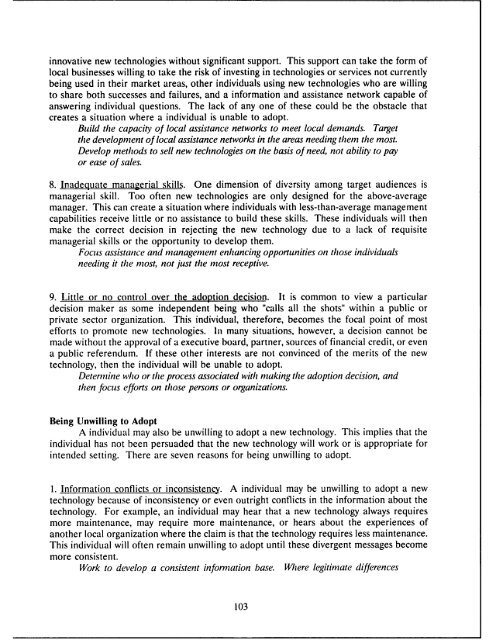Challenges and Opportunities for Innovation in the Public Works ...
Challenges and Opportunities for Innovation in the Public Works ...
Challenges and Opportunities for Innovation in the Public Works ...
Create successful ePaper yourself
Turn your PDF publications into a flip-book with our unique Google optimized e-Paper software.
<strong>in</strong>novative new technologies without significant support. This support can take <strong>the</strong> <strong>for</strong>m of<br />
local bus<strong>in</strong>esses will<strong>in</strong>g to take <strong>the</strong> risk of <strong>in</strong>vest<strong>in</strong>g <strong>in</strong> technologies or services not currently<br />
be<strong>in</strong>g used <strong>in</strong> <strong>the</strong>ir market areas, o<strong>the</strong>r <strong>in</strong>dividuals us<strong>in</strong>g new technologies who are will<strong>in</strong>g<br />
to share both successes <strong>and</strong> failures, <strong>and</strong> a <strong>in</strong><strong>for</strong>mation <strong>and</strong> assistance network capable of<br />
answer<strong>in</strong>g <strong>in</strong>dividual questions. The lack of any one of <strong>the</strong>se could be <strong>the</strong> obstacle that<br />
creates a situation where a <strong>in</strong>dividual is unable to adopt.<br />
Build <strong>the</strong> capacity of local assistance networks to meet local dem<strong>and</strong>s. Target<br />
<strong>the</strong> development of local assistance networks <strong>in</strong> <strong>the</strong> areas need<strong>in</strong>g <strong>the</strong>m <strong>the</strong> most.<br />
Develop methods to sell new technologies on <strong>the</strong> basis of need, not ability to pay<br />
or ease of sales.<br />
8. Inadequate managerial skills. One dimension of diversity among target audiences is<br />
managerial skill. Too often new technologies are only designed <strong>for</strong> <strong>the</strong> above-average<br />
manager. This can create a situation where <strong>in</strong>dividuals with less-than-average management<br />
capabilities receive little or no assistance to build <strong>the</strong>se skills. These <strong>in</strong>dividuals will <strong>the</strong>n<br />
make <strong>the</strong> correct decision <strong>in</strong> reject<strong>in</strong>g <strong>the</strong> new technology due to a lack of requisite<br />
managerial skills or <strong>the</strong> opportunity to develop <strong>the</strong>m.<br />
Focus assistance <strong>and</strong> management enhanc<strong>in</strong>g opportunities on those <strong>in</strong>dividuals<br />
need<strong>in</strong>g it <strong>the</strong> most, not just <strong>the</strong> most receptive.<br />
9. Little or no control over <strong>the</strong> adoption decision. It is common to view a particular<br />
decision maker as some <strong>in</strong>dependent be<strong>in</strong>g who "calls all <strong>the</strong> shots" with<strong>in</strong> a public or<br />
private sector organization. This <strong>in</strong>dividual, <strong>the</strong>re<strong>for</strong>e, becomes <strong>the</strong> focal po<strong>in</strong>t of most<br />
ef<strong>for</strong>ts to promote new technologies. In many situations, however, a decision cannot be<br />
made without <strong>the</strong> approval of a executive board, partner, sources of f<strong>in</strong>ancial credit, or even<br />
a public referendum. If <strong>the</strong>se o<strong>the</strong>r <strong>in</strong>terests are not conv<strong>in</strong>ced of <strong>the</strong> merits of <strong>the</strong> new<br />
technology, <strong>the</strong>n <strong>the</strong> <strong>in</strong>dividual will be unable to adopt.<br />
Determ<strong>in</strong>e who or <strong>the</strong> process associated with mak<strong>in</strong>g <strong>the</strong> adoption decision, <strong>and</strong><br />
<strong>the</strong>n focus ef<strong>for</strong>ts on those persons or organizations.<br />
Be<strong>in</strong>g Unwill<strong>in</strong>g to Adopt<br />
A <strong>in</strong>dividual may also be unwill<strong>in</strong>g to adopt a new technology. This implies that <strong>the</strong><br />
<strong>in</strong>dividual has not been persuaded that <strong>the</strong> new technology will work or is appropriate <strong>for</strong><br />
<strong>in</strong>tended sett<strong>in</strong>g. There are seven reasons <strong>for</strong> be<strong>in</strong>g unwill<strong>in</strong>g to adopt.<br />
1. In<strong>for</strong>mation conflicts or <strong>in</strong>consistency. A <strong>in</strong>dividual may be unwill<strong>in</strong>g to adopt a new<br />
technology because of <strong>in</strong>consistency or even outright conflicts <strong>in</strong> <strong>the</strong> <strong>in</strong><strong>for</strong>mation about <strong>the</strong><br />
technology. For example, an <strong>in</strong>dividual may hear that a new technology always requires<br />
more ma<strong>in</strong>tenance, may require more ma<strong>in</strong>tenance, or hears about <strong>the</strong> experiences of<br />
ano<strong>the</strong>r local organization where <strong>the</strong> claim is that <strong>the</strong> technology requires less ma<strong>in</strong>tenance.<br />
This <strong>in</strong>dividual will often rema<strong>in</strong> unwill<strong>in</strong>g to adopt until <strong>the</strong>se divergent messages become<br />
more consistent.<br />
Work to develop a consistent <strong>in</strong><strong>for</strong>mation base. Where legitimate differences<br />
103







